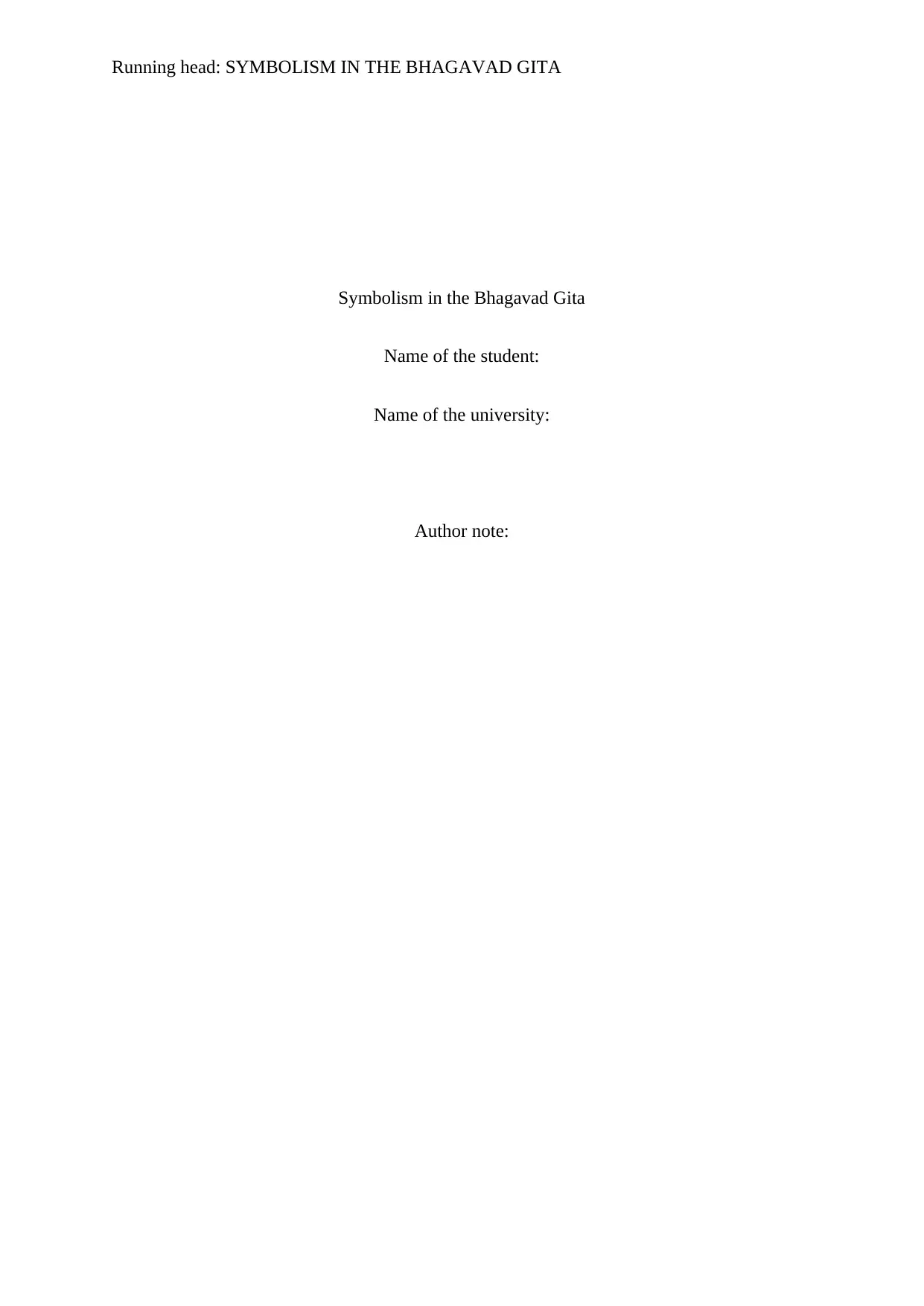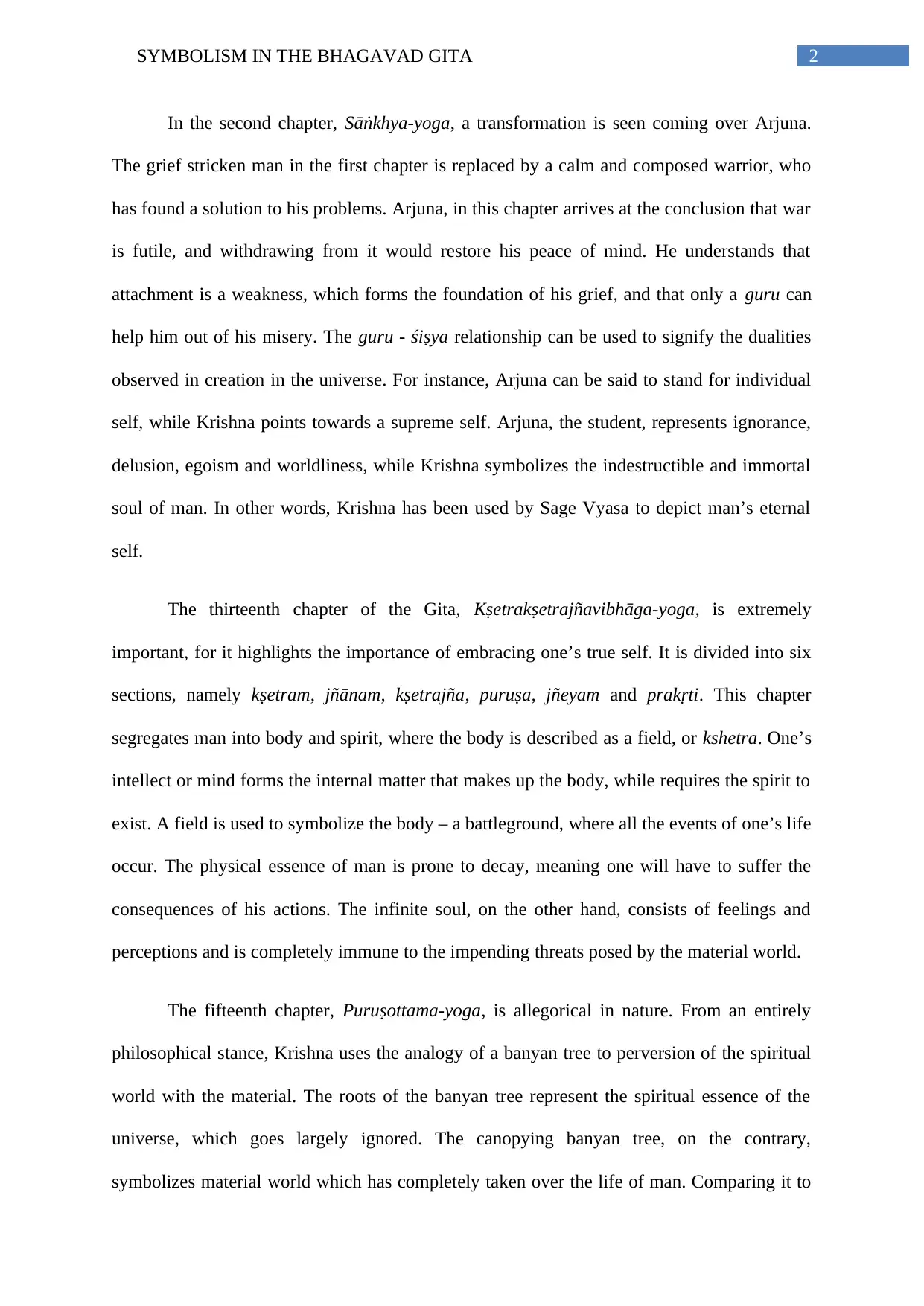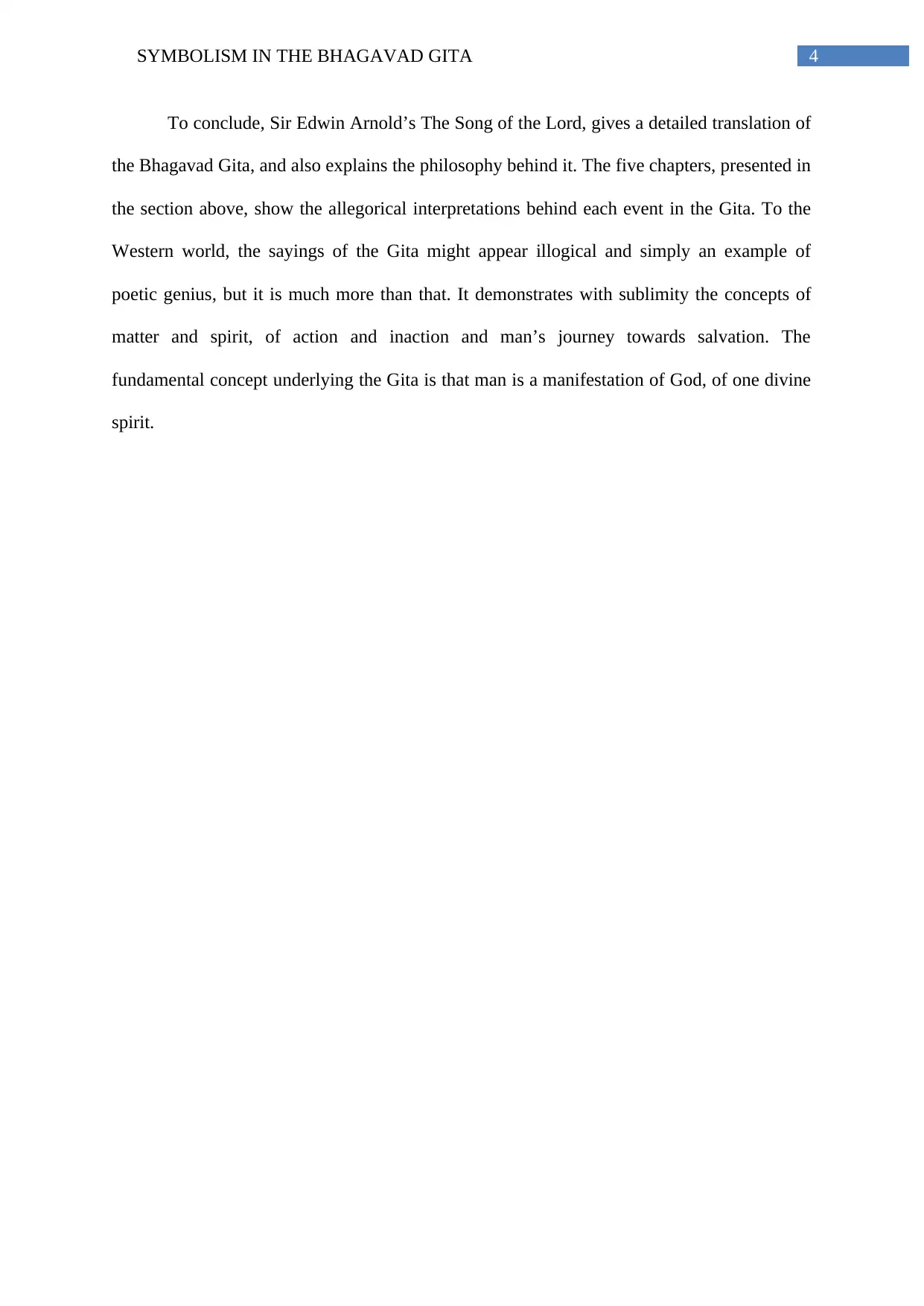Symbolism in the Bhagavad Gita
VerifiedAdded on 2023/06/10
|6
|1411
|424
AI Summary
This article explores the symbolism present in the Bhagavad Gita and its significance in Hindu philosophy. It provides an analysis of the allegories present in each chapter of the Gita, including the chariot as a symbol of the human body and the banyan tree as a representation of the perversion of the spiritual world with the material. The article concludes with the fundamental concept underlying the Gita that man is a manifestation of God.
Contribute Materials
Your contribution can guide someone’s learning journey. Share your
documents today.

Running head: SYMBOLISM IN THE BHAGAVAD GITA
Symbolism in the Bhagavad Gita
Name of the student:
Name of the university:
Author note:
Symbolism in the Bhagavad Gita
Name of the student:
Name of the university:
Author note:
Secure Best Marks with AI Grader
Need help grading? Try our AI Grader for instant feedback on your assignments.

1SYMBOLISM IN THE BHAGAVAD GITA
The Bhagavad Gita, also known as The Song of the Lord, articulates the fundamental
truth of life, as expressed in the Vedanta. It elaborates on the concept of the “self” and the
“I”, of awareness and that of God and all his creations; it also emphasizes on the philosophy
of “tat tvam asi”, which teaches that man is infinite. The Bhagavad Gita is an episode of the
Hindu epic, Maha-Bharata, and is in the form of a conversation between Krishna and Arjuna;
it takes place in a war chariot and depicts Arjuna’s dilemma (Arnold 2017). However, it is
often wrongfully assumed that the Bhagavad Gita is one dimensional in terms of meaning; on
the contrary, the interpretations can be multifaceted. Each chapter of the Gita comprises
certain allegories, all of which point towards the perennial predicament plaguing man in his
day to day struggle for existence. The following paper studies five significant chapters of the
Bhagavad Gita and provides an analysis of the symbolism present in each.
In the first chapter of the Bhagavad Gita, Arjunaviṣāda-yoga, the background for the
epic is set in the Kurukshetra battlefield. This is an introductory chapter, and does not delve
too deep into the philosophy. Yet, it certainly provides some insight into the main characters
and their personalities. The readers are introduced to Dhritarashtra, the blind king and father
of Kuravas, who is fixated on his perspective and refuses to acknowledge other points of
view. In a way, it can be said that he represents spiritual blindness which prevails even today.
Arjuna is also introduced in the first chapter, where he tries to assess the preparations for war
by both armies, following the orders of Krishna. However, the stark reality is staggering as
Arjuna faces conflicting emotions on encountering relatives in the battlefield and eventually
breaks down. A reference is made to the chariot in the first chapter, where it is believed to
symbolize the human body. Basically, the wheels of the chariot signify the wheel of life and
karma. The spokes of the wheel indirectly symbolize the various contradictions and
diversities that shape human existence.
The Bhagavad Gita, also known as The Song of the Lord, articulates the fundamental
truth of life, as expressed in the Vedanta. It elaborates on the concept of the “self” and the
“I”, of awareness and that of God and all his creations; it also emphasizes on the philosophy
of “tat tvam asi”, which teaches that man is infinite. The Bhagavad Gita is an episode of the
Hindu epic, Maha-Bharata, and is in the form of a conversation between Krishna and Arjuna;
it takes place in a war chariot and depicts Arjuna’s dilemma (Arnold 2017). However, it is
often wrongfully assumed that the Bhagavad Gita is one dimensional in terms of meaning; on
the contrary, the interpretations can be multifaceted. Each chapter of the Gita comprises
certain allegories, all of which point towards the perennial predicament plaguing man in his
day to day struggle for existence. The following paper studies five significant chapters of the
Bhagavad Gita and provides an analysis of the symbolism present in each.
In the first chapter of the Bhagavad Gita, Arjunaviṣāda-yoga, the background for the
epic is set in the Kurukshetra battlefield. This is an introductory chapter, and does not delve
too deep into the philosophy. Yet, it certainly provides some insight into the main characters
and their personalities. The readers are introduced to Dhritarashtra, the blind king and father
of Kuravas, who is fixated on his perspective and refuses to acknowledge other points of
view. In a way, it can be said that he represents spiritual blindness which prevails even today.
Arjuna is also introduced in the first chapter, where he tries to assess the preparations for war
by both armies, following the orders of Krishna. However, the stark reality is staggering as
Arjuna faces conflicting emotions on encountering relatives in the battlefield and eventually
breaks down. A reference is made to the chariot in the first chapter, where it is believed to
symbolize the human body. Basically, the wheels of the chariot signify the wheel of life and
karma. The spokes of the wheel indirectly symbolize the various contradictions and
diversities that shape human existence.

2SYMBOLISM IN THE BHAGAVAD GITA
In the second chapter, Sāṅkhya-yoga, a transformation is seen coming over Arjuna.
The grief stricken man in the first chapter is replaced by a calm and composed warrior, who
has found a solution to his problems. Arjuna, in this chapter arrives at the conclusion that war
is futile, and withdrawing from it would restore his peace of mind. He understands that
attachment is a weakness, which forms the foundation of his grief, and that only a guru can
help him out of his misery. The guru - śiṣya relationship can be used to signify the dualities
observed in creation in the universe. For instance, Arjuna can be said to stand for individual
self, while Krishna points towards a supreme self. Arjuna, the student, represents ignorance,
delusion, egoism and worldliness, while Krishna symbolizes the indestructible and immortal
soul of man. In other words, Krishna has been used by Sage Vyasa to depict man’s eternal
self.
The thirteenth chapter of the Gita, Kṣetrakṣetrajñavibhāga-yoga, is extremely
important, for it highlights the importance of embracing one’s true self. It is divided into six
sections, namely kṣetram, jñānam, kṣetrajña, puruṣa, jñeyam and prakṛti. This chapter
segregates man into body and spirit, where the body is described as a field, or kshetra. One’s
intellect or mind forms the internal matter that makes up the body, while requires the spirit to
exist. A field is used to symbolize the body – a battleground, where all the events of one’s life
occur. The physical essence of man is prone to decay, meaning one will have to suffer the
consequences of his actions. The infinite soul, on the other hand, consists of feelings and
perceptions and is completely immune to the impending threats posed by the material world.
The fifteenth chapter, Puruṣottama-yoga, is allegorical in nature. From an entirely
philosophical stance, Krishna uses the analogy of a banyan tree to perversion of the spiritual
world with the material. The roots of the banyan tree represent the spiritual essence of the
universe, which goes largely ignored. The canopying banyan tree, on the contrary,
symbolizes material world which has completely taken over the life of man. Comparing it to
In the second chapter, Sāṅkhya-yoga, a transformation is seen coming over Arjuna.
The grief stricken man in the first chapter is replaced by a calm and composed warrior, who
has found a solution to his problems. Arjuna, in this chapter arrives at the conclusion that war
is futile, and withdrawing from it would restore his peace of mind. He understands that
attachment is a weakness, which forms the foundation of his grief, and that only a guru can
help him out of his misery. The guru - śiṣya relationship can be used to signify the dualities
observed in creation in the universe. For instance, Arjuna can be said to stand for individual
self, while Krishna points towards a supreme self. Arjuna, the student, represents ignorance,
delusion, egoism and worldliness, while Krishna symbolizes the indestructible and immortal
soul of man. In other words, Krishna has been used by Sage Vyasa to depict man’s eternal
self.
The thirteenth chapter of the Gita, Kṣetrakṣetrajñavibhāga-yoga, is extremely
important, for it highlights the importance of embracing one’s true self. It is divided into six
sections, namely kṣetram, jñānam, kṣetrajña, puruṣa, jñeyam and prakṛti. This chapter
segregates man into body and spirit, where the body is described as a field, or kshetra. One’s
intellect or mind forms the internal matter that makes up the body, while requires the spirit to
exist. A field is used to symbolize the body – a battleground, where all the events of one’s life
occur. The physical essence of man is prone to decay, meaning one will have to suffer the
consequences of his actions. The infinite soul, on the other hand, consists of feelings and
perceptions and is completely immune to the impending threats posed by the material world.
The fifteenth chapter, Puruṣottama-yoga, is allegorical in nature. From an entirely
philosophical stance, Krishna uses the analogy of a banyan tree to perversion of the spiritual
world with the material. The roots of the banyan tree represent the spiritual essence of the
universe, which goes largely ignored. The canopying banyan tree, on the contrary,
symbolizes material world which has completely taken over the life of man. Comparing it to

3SYMBOLISM IN THE BHAGAVAD GITA
a tree, Krishna also emphasizes on the ephemeral nature of such a life since the tree of
material existence is bound to perish someday. This chapter of the Gita can thus be
interpreted as a call back to one’s real self, or the spiritual world that forms the basis of all
existence.
The final chapter, Mokṣasannyāsa-yoga, is a culmination of all the philosophies
underlying the Gita. Here, as an answer to Arjuna’s question, Krishna attempts to distinguish
between tyāga and sannyāsa. Krishna opines that an act can only be considered sacrifice
when it is free of selfish intent. This means that the individual cannot call giving up
obligatory work sacrificial for the sake of achieving something. He needs to free his soul of
the outcome, if his act is to be deemed one of true sacrifice. Renunciation of worldly
pleasures and attachment is the only way to achieve true tyāga. The chapter ends with
Krishna eliminating Arjuna’s doubts, and clearing him of any delusion. Being a dutiful
student, Arjuna complies and vows to abide by his guru’s teachings.
The Bhagavad Gita holds a superior position in the canon of religious literature. Man
should remain focused on his work, without paying heed to the final outcome. In other words,
the outcome should not predetermine man’s actions. The various aphorisms, versifications,
shlokas and sutras in the Gita render it multi layered. Every character and personality in the
Gita has a symbolic significance; man’s life is depicted as dharmakshetra, where he is
expected to stay true to his duties. There is divinity hidden in every man, but often suppressed
under layers of delusion and ignorance. Led by blind ego, like Dhritarashtra, man descends
into negative impulses. Man’s personality can be compared to Kurukshetra, a battlefield, and
he embarks on a chariot, on a quest for enlightenment. Eventually, it is a realization of his
virtues and spirituality that transcends his soul and leads him on a path to salvation.
a tree, Krishna also emphasizes on the ephemeral nature of such a life since the tree of
material existence is bound to perish someday. This chapter of the Gita can thus be
interpreted as a call back to one’s real self, or the spiritual world that forms the basis of all
existence.
The final chapter, Mokṣasannyāsa-yoga, is a culmination of all the philosophies
underlying the Gita. Here, as an answer to Arjuna’s question, Krishna attempts to distinguish
between tyāga and sannyāsa. Krishna opines that an act can only be considered sacrifice
when it is free of selfish intent. This means that the individual cannot call giving up
obligatory work sacrificial for the sake of achieving something. He needs to free his soul of
the outcome, if his act is to be deemed one of true sacrifice. Renunciation of worldly
pleasures and attachment is the only way to achieve true tyāga. The chapter ends with
Krishna eliminating Arjuna’s doubts, and clearing him of any delusion. Being a dutiful
student, Arjuna complies and vows to abide by his guru’s teachings.
The Bhagavad Gita holds a superior position in the canon of religious literature. Man
should remain focused on his work, without paying heed to the final outcome. In other words,
the outcome should not predetermine man’s actions. The various aphorisms, versifications,
shlokas and sutras in the Gita render it multi layered. Every character and personality in the
Gita has a symbolic significance; man’s life is depicted as dharmakshetra, where he is
expected to stay true to his duties. There is divinity hidden in every man, but often suppressed
under layers of delusion and ignorance. Led by blind ego, like Dhritarashtra, man descends
into negative impulses. Man’s personality can be compared to Kurukshetra, a battlefield, and
he embarks on a chariot, on a quest for enlightenment. Eventually, it is a realization of his
virtues and spirituality that transcends his soul and leads him on a path to salvation.
Secure Best Marks with AI Grader
Need help grading? Try our AI Grader for instant feedback on your assignments.

4SYMBOLISM IN THE BHAGAVAD GITA
To conclude, Sir Edwin Arnold’s The Song of the Lord, gives a detailed translation of
the Bhagavad Gita, and also explains the philosophy behind it. The five chapters, presented in
the section above, show the allegorical interpretations behind each event in the Gita. To the
Western world, the sayings of the Gita might appear illogical and simply an example of
poetic genius, but it is much more than that. It demonstrates with sublimity the concepts of
matter and spirit, of action and inaction and man’s journey towards salvation. The
fundamental concept underlying the Gita is that man is a manifestation of God, of one divine
spirit.
To conclude, Sir Edwin Arnold’s The Song of the Lord, gives a detailed translation of
the Bhagavad Gita, and also explains the philosophy behind it. The five chapters, presented in
the section above, show the allegorical interpretations behind each event in the Gita. To the
Western world, the sayings of the Gita might appear illogical and simply an example of
poetic genius, but it is much more than that. It demonstrates with sublimity the concepts of
matter and spirit, of action and inaction and man’s journey towards salvation. The
fundamental concept underlying the Gita is that man is a manifestation of God, of one divine
spirit.

5SYMBOLISM IN THE BHAGAVAD GITA
References:
Arnold, E., 2017. Routledge Revivals: The Song Celestial or Bhagavad-Gita (1906): From
the Mahabharata. Routledge.
References:
Arnold, E., 2017. Routledge Revivals: The Song Celestial or Bhagavad-Gita (1906): From
the Mahabharata. Routledge.
1 out of 6
Your All-in-One AI-Powered Toolkit for Academic Success.
+13062052269
info@desklib.com
Available 24*7 on WhatsApp / Email
![[object Object]](/_next/static/media/star-bottom.7253800d.svg)
Unlock your academic potential
© 2024 | Zucol Services PVT LTD | All rights reserved.
